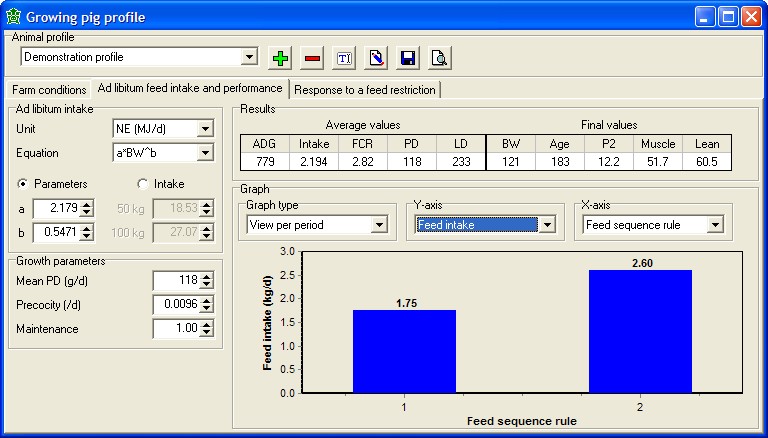Parameterization of an animal profile for growing pigs
Parameterizing an animal profile is a essential element of InraPorc. An animal profile describes the phenotypic growth and feed intake potential of the pig (i.e., the potential of a genotype in a production setting). Consequently, specific model parameters have to be found for each production setting.
InraPorc uses the shape of the feed intake curve and the growth curve to determine nutrient requirements. Consequently, having only information on the average feed intake and growth will not allow describing both curves (other than using default values for the shape parameters). However, if data for feed intake and growth are available for two (or more) periods, specific feed intake and growth curves can be constructed. In the remainder of this text, we will describe how to obtain model parameters (for the growing pig profile) based on feed intake and growith obtained during two periods. The purpose of the exercise is to find model parameters that correspond (approximately) to the following situation:
|
Average |
Grower phase |
Finisher phase |
Intake (kg/d) |
2.20 |
1.75 |
2.60 |
Average daily gain (g/d) |
775 |
700 |
850 |
Feed conversion ratio |
2.84 |
2.50 |
3.06 |
Finding the parameters that correspond to this situation is an iterative (and manual) procedure. We will first try to find parameters in which model predictions correspond to the desired values for average feed intake and daily gain. Once we have found these, we will adjust the parameters affecting the kinetics of feed intake and growth so that the predicted intake and daily gain for the grower and finisher phases correspond to the desired values.
To fully exploit the procedure, we recommend to create a new animal profile. This can be done by clicking on the green '+' button without copying the values of the current profile.
Farm conditions
Select a feed sequence plan in which the amino acid supply is not limiting performance (e.g., a bi-phase, normal CP diet). Although you theoretically can use any feed sequence plan, it is very convenient to use a feed sequence plan with two rules. In doing so, you can display the results (feed intake and weight gain) for each rule, which will allow you to easily evaluate the model predictions while parametering. The two rules you use in the feed sequence plan should correspond to the periods for which you have the data. For the purpose of this exercise, we recommend that you use the default values for initial age (60 days) and body weight (25 kg). The final state can be set at 120 kg.
Ad libitum intake and performance
Let us assume that voluntary intake is determined by net energy. We will select the equation NE = a BWb , where 'a' is a scale parameter, and 'b' a shape parameter. The values that are currently listed are default values. Adjust the scale parameter 'a' so that the average feed intake corresponds closely to 2.20 kg/d.
The parameter 'mean PD' has an important impact on the average daily gain. Adjust this parameter so that the average daily gain is close to 775 g/d. Notice also that, while doing so, the predicted average intake will slightly deviate from the value you had before (close to 2.20 kg/d). You may adjust the intake parameter 'a' again so that you find your target intake again.
Now display the simulation results using the graph-display 'View per period' and select 'Feed intake' as Y-axis, and 'Feed sequence rule' as X-axis. Click on the radio-button ‘Intake' in the zone describing the ad libitum intake parameters. This will allow you to adjust the predicted intake (average and for both periods) using the NE-intake at 50 and 100 kg of body weight. Adjusting the parameter for 50 kg BW will mostly adjust intake during the grower phase whereas adjusting the parameter at 100 kg BW corresponds mostly to the finisher phase.
After the intake adjustment, display 'Weight gain' as the Y-axis. Adjust the precocity parameter so that predicted daily gain in both periods corresponds to the observed values. Make (minor) adjustments to the intake parameters (and growth parameters again) to that both predicted intake and daily gain corresponds to the observed values.
The final parameter values should be very close to what you see below, although small deviations from the desired values can occur.
